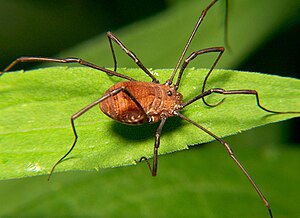Harvestman
| Opiliones Temporal range: 400–0 Ma Early Devonian – Holocene |
|
|---|---|
 |
|
| Opiliones (Hadrobunus grandis) showing its body structure and long legs: A sole pair of eyes and unitary cephalothorax differentiate the Opiliones from other members of the class Arachnida. | |
| Scientific classification | |
| Kingdom: | Animalia |
| Phylum: | Arthropoda |
| Subphylum: | Chelicerata |
| Class: | Arachnida |
| Order: |
Opiliones Sundevall, 1833 |
| Suborders | |
| Diversity | |
| 5 suborders, > 6,500 species | |
The Opiliones (/ˈoʊpɪliːˈoʊniːs/; formerly Phalangida) are an order of arachnids colloquially known as harvestmen, harvesters or daddy longlegs. Although both harvestmen and spiders are arachnids, the two orders are not otherwise closely related. As of December 2011[update], over 6,500 species of harvestmen have been discovered worldwide, although the total number of extant species may exceed 10,000. The order Opiliones includes five suborders: Cyphophthalmi, Eupnoi, Dyspnoi, Laniatores, and the recently named Tetrophthalmi. With the exception of the Dyspnoi (which are restricted to North America and Eurasia), representatives of each can be found on every continent except Antarctica. Well-preserved fossils have been found in the 400-million-year-old Rhynie cherts of Scotland, and 305-million-year-old rocks in France, which look surprisingly modern, indicating that their basic body plan appeared very early on, and, at least in some taxa, has changed little since that time. Their phylogenetic position within the Arachnida is disputed: their closest relatives may be the mites (Acari) or the Novogenuata (the Scorpiones, Pseudoscorpiones, and Solifugae). Although superficially similar to and often misidentified as spiders (order Araneae), the Opiliones are a distinct order that is not closely related to spiders. They can be easily distinguished from long-legged spiders by their fused body regions and single pair of eyes in the middle of the cephalothorax. Spiders have a distinct abdomen that is separated from the cephalothorax by a constriction, and they have three to four pairs of eyes, usually around the margins of the cephalothorax.
...
Wikipedia
